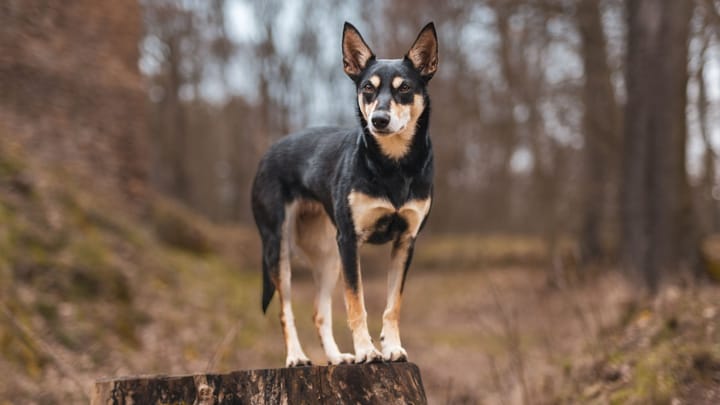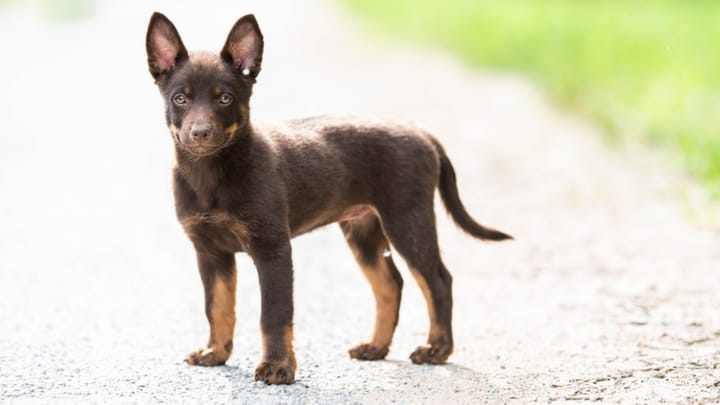Australian Kelpie
Other name: Kelpie


Motivated, energetic, focused, devoted and independent? That’s the Australian Kelpie for you. A breed with seemingly endless stamina, they were originally bred to herd livestock day-in-day-out and are independent thinkers at heart.
As a pet, they’re loyal, devoted and friendly in the right home. Without frequent exercise, thorough training and lots of mental stimulation, the Kelpie can be challenging and destructive.
They’re known to bond strongly to one member of the family, so if you’re looking for a loyal, loving companion for one (active) person specifically, the Australian Kelpie might be the perfect choice.
|
Life expectancy |
The Australian Kelpie has a life expectancy of between 12 and 14 years |
|
Temperament |
|
|
Size |
Medium
|
|
Adult size |
Female
Between 17 and 19 in
Male
Between 18 and 20 in
|
|
Adult weight |
Female
Between 24 and 33 lb
Male
Between 29 and 49 lb
|
|
Coat colour
The Kelpie’s coat comes in:
|
Black Brown Red Blue |
|
Type of coat
Their coat is medium length. The Australian Kelpie’s double coat is short, straight, harsh-textured, and waterproof. The thick undercoat provides plenty of protection against wind, rain and cold temperatures. |
Long Hard |
|
Eye colour
The eyes range from shades of gold to deep brown, depending on the coat colour. |
Brown
|
|
Purchase price |
The Australian Kelpie costs approximately 340£ |
The first ever recorded Kelpie is believed to be a female black-and-tan puppy, whose records date back to 1860.
More details about the Australian Kelpie
Australian Kelpie: Origins and history
The hot, dusty outback climate takes a tough working dog - and that’s exactly what the Australian Kelpie was bred for! This hardy dog can cope well in all sorts of conditions and, therefore, has been used as a working dog in Australia for hundreds of years. However, no one is completely sure how this breed was created, though it’s thought to be related to the Collie.
Physical characteristics of the Australian Kelpie
This medium-sized breed has a compact yet muscular body, which is longer than it is tall. The legs are clearly powerful and muscled for their size. The head is narrow with a rounded skull, while the tail is set low and is medium in length. They’re easily recognisable by their pointy, prominent ears and expressive, alert, almond-shaped eyes. Overall, this breed has an athletic, durable and rather charming appearance.
FCI classification of the Australian Kelpie
-
Group 1 - Sheepdogs and Cattledogs (except Swiss Cattledogs)
-
Section 1 : Sheepdogs
Australian Kelpie: Characteristics
Australian Kelpie: Behaviour
Training a Australian Kelpie
It is a dog easy to educate, thanks to his great attention and his taste for learning.
Australian Kelpie: Lifestyle
Breed compatibility Australian Kelpie
Australian Kelpie: Purchase price
This breed is fairly easy to come across in the UK. You should be able to pick one up for around £340. Make sure you’re purchasing from a reliable, trusted breeder and meet the parents if possible.
Concerning your monthly budget, on average to fulfill this dog's need, you can count between £20-£30.
Australian Kelpie: Shedding
Average
This breed does shed quite a lot, especially considering their short coat. They shed throughout the year but more so during the spring and autumn months. Frequent brushing can help prevent a mess.
Australian Kelpie: Grooming
The Australian Kelpie is incredibly low maintenance in terms of grooming. Their short double coat only needs a brush once or twice a week, though daily brushing can help to minimize shedding.
The Kelpie’s nails tend to file down naturally (assuming they get enough exercise), though they should still be checked occasionally. Everything else comes as standard - teeth should be brushed as regularly as possible and ears should be checked and cleaned if necessary.
Australian Kelpie: Health
12-15 years.
Despite only being a medium-sized breed, the Kelpie is fairly strong, powerful, resilient and independent.
Bred to work long hours out in the sizzling Australian heat, the Kelpie is well-suited to hot weather. Despite their tolerance to heat, they should still be given access to shade and plenty of water.
The Kelpie’s coat is weather-resistant, allowing them to withstand cold and windy climates.
As such an active breed, the Australian Kelpie is unlikely to become overweight. However, if kept as a pet and not given adequate exercise, the weight could slip on - making for a very unhappy, unfulfilled pooch.
- Hip dysplasia
- Elbow dysplasia
- Luxating Patella
- Cryptorchidism
- Cerebellar abiotrophy
- Deafness
- Progressive retinal atrophy








